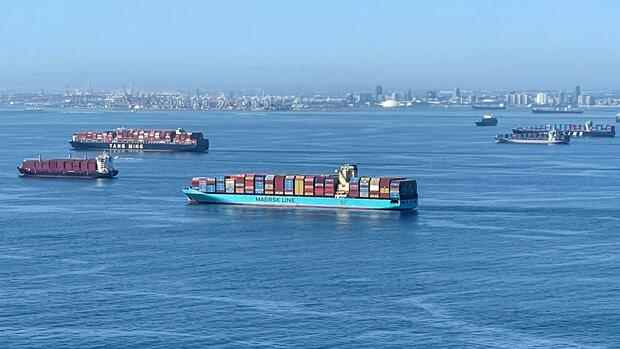New York, San Francisco The ride over the new, glistening white Bay Bridge from San Francisco to Oakland is an unusual sight these days. Between six and 15 ships, large and small, are always bobbing in the bay, sometimes waiting for days for permission to enter one of the largest ports on the west coast of the USA and unload their cargo. For the economy, just a few weeks before the holidays, this is a disaster.
Six hours by car further south, in Los Angeles, the situation is no better: aerial views of the sea off Long Beach, the largest west coast port, look like a crowded shopping mall parking lot on Christmas Eve. 40 waiting ships and more are not uncommon, days have long since turned into weeks of lay time.
Then there are the enormous costs: Shipping a container from Asia to the USA costs 20,000 dollars today, almost ten times as much as it did two years ago. Many large US companies have therefore decided to take their logistics more into their own hands. The retailers Walmart, Costco and Target have chartered their own ships for the holiday season. Amazon wants to invest billions in its own fleet of planes and trucks.
The Swedish furniture store Ikea has also announced that it will buy containers and charter ships. “This is the perfect storm,” said Jesper Brodin, CEO of the Ingka Group, which controls most of the Ikea stores, in October. “This is the new normal for us. And when things calm down, we will have learned a lot about agility, ”he prophesies.
Top jobs of the day
Find the best jobs now and
be notified by email.
Coca-Cola has also recently shown itself to be agile: the beverage manufacturer recently even rented several coal freighters because ships have become so scarce. Walmart is increasingly chartering smaller ships. They can also be used by retailers to go to smaller, less crowded ports than those in Southern California and thus unload their cargo faster and get it onto the streets or railroad tracks.
A container ship costs up to $ 140,000 a day
By chartering their own ships, the big chains have more control over where their goods are than if they had their containers shipped through logistic companies. For example, you can order a ship to call at another port if the original one is congested. But that’s not exactly cheap: a container ship can cost up to $ 140,000 a day.
Amazon is furthest on the way to logistical independence. In January, the online retailer ordered a further eleven Boeing 767s to expand its cargo fleet to 85 planes. On October 25, Amazon announced that it had doubled its container capacity and entered into several partnerships. Now he’s investing billions more.
Other companies are increasingly switching to air freight: Home Depot, for example, doesn’t just charter its own ships. The hardware store chain also has the higher-margin electrical tools transported by plane so that they get to the shelves more quickly.
US companies are looking for ways out of the delivery bottlenecks.
(Photo: Bloomberg)
The logistics provider DHL is also feeling the effects of the higher demand for air freight, reports David Goldberg, US head of the freight forwarding business of the Post subsidiary. explains the manager. Many customers no longer looked primarily at the costs. It is much more important to them that their goods are available.
In addition, DHL offers its customers the option of taking over the logistics for the entire supply chain so that they can concentrate on their core business. “This business model has probably never been as popular as it has been in the past two years,” says Goldberg. In the third quarter, new business in this area grew 16 percent worldwide, and in e-commerce even more than 100 percent. The greatest growth came from America.
Almonds and nuts have to arrive in Europe before Christmas
However, the chaos in the California ports will not subside anytime soon. With a container ship, you can’t just turn around and load your goods elsewhere if something gets stuck. Ultimately, this is based on contracts with warehouses, truck and rail providers who have to forward or deliver the goods. Trained employees have to load and unload the ships with the greatest care according to precisely defined plans in order to avoid a disaster.
And those who produce in Northern California cannot even deliver in Los Angeles or Portland in the neighboring state of Oregon. That affects everyone. California is about the largest producer of nuts such as almonds, walnuts and pistachios in the USA, the export value is around eight billion dollars annually. Roger Isom, President of the Californian Agriculture Association CCGGA, gives an example: In October, almost 80 percent of all delivery trips already booked were simply canceled.
The goods are now on their way to Texas in long trains to be shipped from there. That costs a lot of time and money and becomes a race against time. The nuts must be in Europe before the baking time for Christmas. Cotton producers sometimes fly the bales to Peru at horrendous prices in order to comply with delivery obligations subject to penalties and not to lose customers. One association member alone has already lost $ 7.5 million because his goods simply do not come from the warehouses to the customers, reports Isom.
“The smaller ports like Oakland are simply passed over, no longer called at all,” says Isom. The ships that got rid of their cargo in Los Angeles are going back to China as soon as possible. And so nuts, cotton, fruits and other goods are piled up in the warehouses.
More: Dax companies make 90 billion euros in profit in nine months – but the worries are growing
